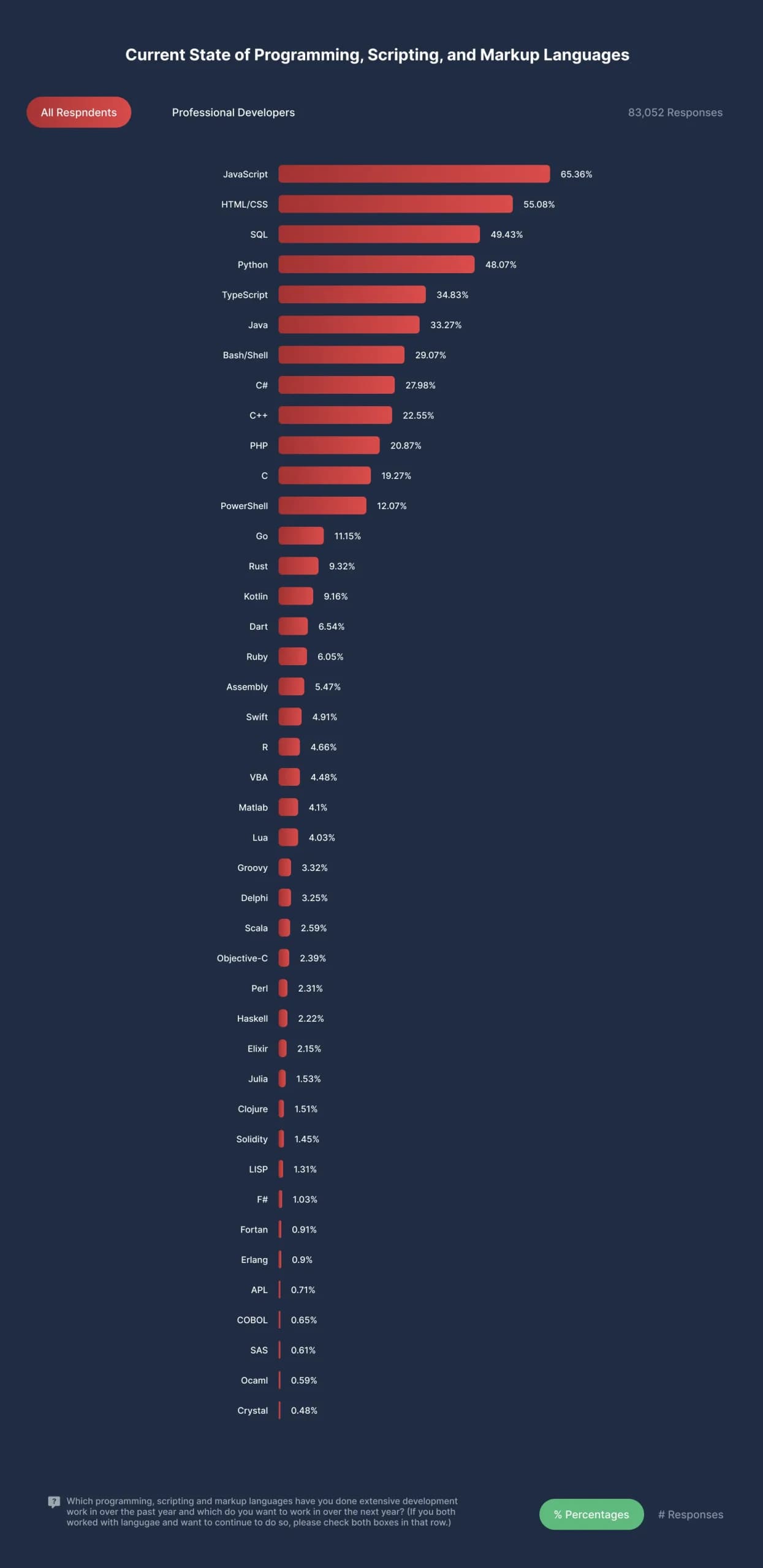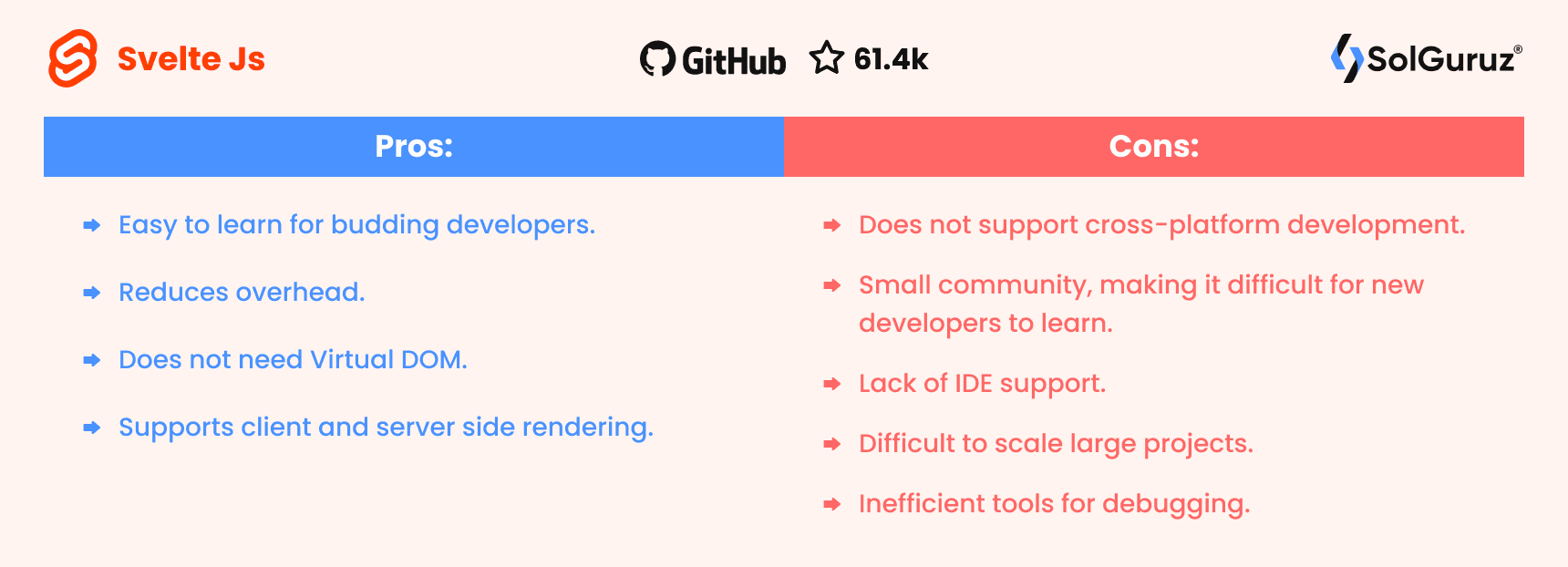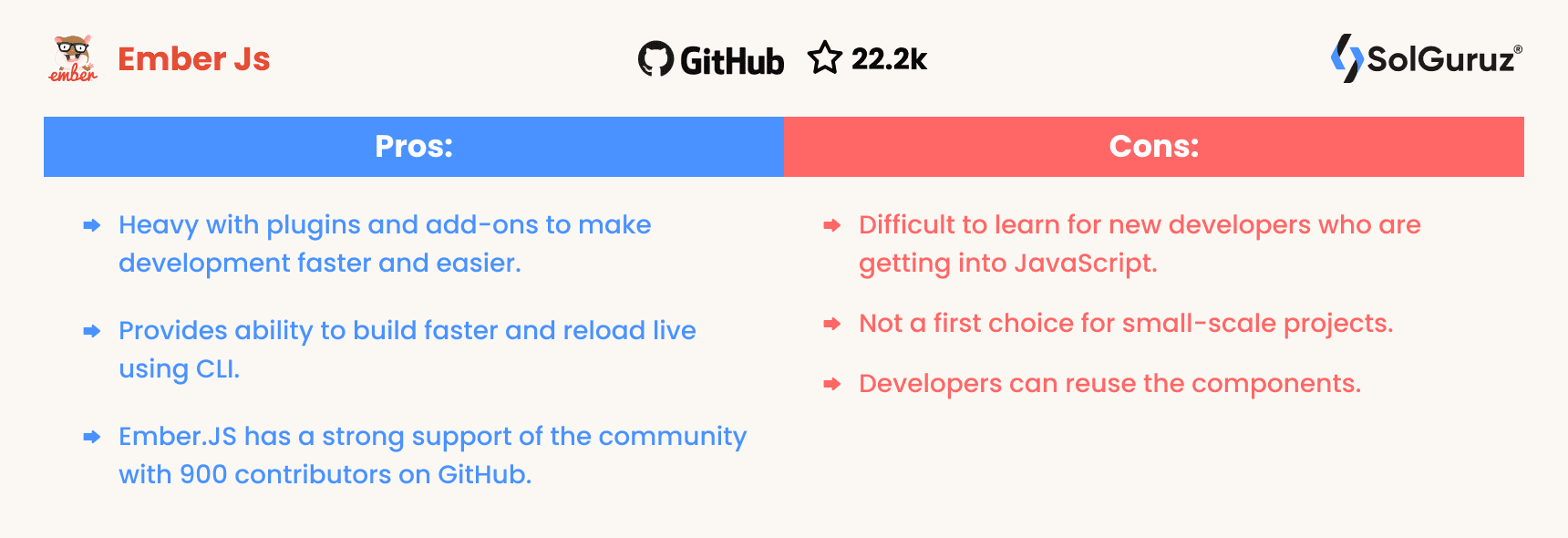Top JavaScript Frameworks in 2025
Learn about the top JavaScript frameworks and know how to choose the right one. Read more to know about JavaScript Frameworks.

In this article today, we are going to talk about the top JavaScript Frameworks in 2025 for Front-End and Back-end.
We all have seen the rapid growth and evolution of programming languages over a decade.
Programming languages have evolved a lot over the decades. There has been constant work to make these languages better so they enhance the overall development practices. Today, we can use various JavaScript frameworks, .NET frameworks, etc., along with their libraries to develop applications faster and in a better way.
If we look back in time and think about the time we wrote our first line of code, we remember how many lines we wrote for the “Hello World” program. Hence, the development has become better over the years.
Today when we talk about development languages, one word which you might often hear from everyone is “JavaScript”. Since its inception, JavaScript has made development better, faster, and easier for developers.
Herein, we will dive deep into JavaScript frameworks and learn how they have evolved over a year.
Let’s begin:
Table of Contents
Brief History of JavaScript
The story of JavaScript came into existence as Netscape wanted to make the client-side web more interactive. Brendan Eich developed JavaScript in 1995. Initially, the project’s name was Mocha. Later in September, the first stable release was there and was called LiveScript. Finally, the beta version 3 was released in December 1995 with the official name, which we all know today: JavaScript.
What is JavaScript?
JavaScript is a text-based programming language useful for client-side and server-side applications to make web pages interactive. It helps overcome the shortcomings of HTML and CSS by making them interactive.
According to research done by Stackoverflow, 65.36% of developers prefer to use JavaScript.

Going further, let’s see the usage of JavaScript:
Core Areas where JavaScript is Used
-
Making Web Pages Interactive:
JavaScript leads the market when it comes to making interactive web pages. Many leading companies like Google, YouTube, and Facebook use JavaScript. Additionally, it also allows developers to implement features like:
- Easily adding hover effects
- Creating carousels for images
- Zooming in and out of images
- Adding animations
- Playing audio-video on your web page
And more…
-
Developing Web and Mobile Apps
JavaScript has an extensive collection of frameworks that developers can easily use to build mobile and web applications. JavaScript frameworks are the pre-written JavaScript code that developers use for standard features. Below are some of the popular JavaScript frameworks:
- React
- React Native
- Node.JS
Going further, we will see each of them and others in detail.
-
Developing Web Servers and Server Applications
JavaScript is widely used for back-end or server-side development because it makes a call to the remote server when a web page loads on the browser. When a browser loads a web page, it makes a call to a remote server. Further, the code parses the page’s URL to understand users’ requirements before retrieving and transforming the required data to serve back to the browser. The widely used framework for this is Node.JS.
Here’s a quick guide to Node.JS vs Python.
-
Game Development
JavaScript is useful to create in-browser games. Developers use it to create 2D and 3D puzzles, role-playing games, racing games, platform games, etc. There are many JavaScript game engines that provide frameworks for building games, many of which are free and open-source. The most popular engines are Backbone, DarlingJS, and JawsJS.
Some of the popular games built using JavaScript are:
- Angry Birds
- 2048
- Polycraft
- Little Alchemy
And more…
-
Artificial Intelligence
JavaScript is useful for developing AI, as libraries like TensorFlow bring the power of machine learning to JavaScript developers. Today developers can rely on these libraries to create machine learning models and are changing the world in a better way.
-
Virtual Reality
Using JavaScript, you can develop applications for Virtual Reality. In fact, one of the most popular frameworks is A-Frame when it comes to building an application with an aim to provide a better experience in the web browser.
A-Frame is a popular JavaScript framework used to build virtual reality experiences in web browsers.
What is a JavaScript Framework?
JavaScript framework allows access to JS code libraries using publicly available source code to save time on development codes. Using the framework, you don’t need to do the nitty-gritty of code. Moreover, there are already coded components that you can use in your source code. Thus, making you code faster and better as a developer.
Why Developers are Shifting to Javascript:
Developers widely prefer to use JavaScript as it helps them enhance their development skills. Below are the three major reasons developers use JavaScript:
-
Saves Time
Using frameworks helps decrease development time, as a result enhancing overall productivity. You can explore a large library with various features that help you to build on your imagination.
-
Enhances Agile Software Development
JavaScript has enabled easy and fast agile development with the help of libraries. Developers today can develop an application or website quickly with the help of these existing libraries.
-
Quick to Launch
JavaScript helps you to develop and launch products quickly. With the large amount of existing libraries, developers can quickly develop an application, saving plenty of time and resources. This, in turn, helps businesses to launch their product quickly in the market and provide services to their customers.
Next up, let’s see the current state of JavaScript Frameworks.
Current State of JavaScript Frameworks:
JavaScript has plenty of frameworks which we will see going further. When it comes to choosing a framework that is the best, there is no one answer. There are many features and variables that are considered while understanding which is the best framework and why developers prefer it.
When it comes to choosing the most popular framework, we consider data from GitHub Stars, NPM Downloads, Developer Survey Results, etc. According to research from Statista, the top 2 best frameworks are ReactJS and jQuery, surpassing others. This data shows that even after a decade of being launched, JavaScript is ruling the development world.
Now, let’s take a high-level view of the JavaScript Frameworks and Web Technologies Survey 2022 published by StackOverflow. As per the report, Node.js and React.js are the two most popular JavaScript frameworks used by professional developers and those learning to code. Angular is more popular among Professional Developers than those learning to code (23% vs 10%).

Thus, we can say that JavaScript and its framework have come a long way.
One of the major questions that everyone asks is the difference between the JavaScript framework and the JavaScript Library. So, let’s clear up this confusion.
JavaScript Frameworks Vs. JavaScript Library:
The difference between frameworks and libraries is that libraries consist of functions that an application calls to perform a task. Whereas a framework defines the way developers design an application. When you are considering a JavaScript library or framework, here are certain questions you should ask yourself:
- Is the library or framework you are choosing flexible?
- What is the regularity of updates in the library or framework, and is it compatible with new standards?
- Is the library or framework secured?
- How is the community support of the library and framework you are choosing?
Answering these questions will guide you towards choosing the right framework and library for your project.
Next up, let’s see the famous JavaScript frameworks in detail:
JavaScript Frameworks:
JavaScripts frameworks are divided into two forms:
- Front-end JavaScript Frameworks
- Back-end JavaScript Frameworks
Top Front-end JavaScript Frameworks:
1. Vue.JS
Vue.JS is a progressive framework used for building one-page applications. It is useful and designed for scalability and incrementality. Moreover, it is easy to integrate with other libraries and is focused on the view layer. It is widely useful and accepted in the developer ecosystem to develop desktop and mobile-based applications.
Vue.JS uses MVC (Model-View-Controller) architecture and can be useful along with different architectural frameworks like CBA (Component-Based-Architecture). It has a unique ability to interact with various available frameworks, which has made Vue.JS a go-to choice for web development.

Pros:
- Low storage requirements
- Easy and simple to learn
- Easy integration between HTML and JavaScript
- Developers can reuse the components
- Vue.JS uses component-based architecture, which makes it easier for developers to reuse components and is good for unit testing.
Cons:
- It has a restricted community and language barriers
- Lack of financial support for large-scale projects
- Vue.JS has a limited number of plugins and other resources compared to other JavaScript frameworks
Are you thinking of developing a Vue.JS application? Hire VueJS developers from SolGuruz! We can be your one-stop web development partners in developing a wide range of custom software.
2. AngularJS
AngularJS is an open-source framework used for developing web applications. Google developed it and made it open-source in 2010. It is one of the top choices of developers when it comes to building web applications using JavaScript. Hire web developers from SolGuruz and allow us to help you build white-label solutions.

Pros:
- Two-way data binding
- Improves performance of the server
- Faster application prototyping
- Easy to develop responsive applications
- It uses MVVM architecture
Cons:
- JavaScript support is necessary
- Difficult to learn for new developers
- Lack of SEO support
- Difficult to migrate from one version to another
- Difficult to debug the code
3. Svelte JS
SvelteJS is a modern JavaScript framework that is useful for building static web apps that are fast, lean, and fun. You can use Svelte to build single, reusable components and large or even small-scale projects. Svelte has started gaining attention because of its ability to produce smaller code bundles that run faster in web browsers.

Pros:
- Easy to learn for budding developers
- Reduces overhead
- Does not need a Virtual DOM
- Supports client and server-side rendering
Cons:
- Does not support cross-platform development
- A small community, making it difficult for new developers to learn
- Lack of IDE support
- Difficult to scale large projects
- Inefficient tools for debugging
4. ReactJS
ReactJS is a JavaScript based UI development library which is developed by Facebook. It is an open-source framework which is widely used by developers for web development. One of the major reasons why React.JS is widely popular is because it uses Virtual DOM. This enables developers to create web applications faster.

Pros:
- Easy to learn and use
- Creating dynamic web applications becomes faster
- Reusable components
- SEO friendly
- Easy to test the code
Cons:
- Poor documentation makes it difficult for new developers to learn it faster.
- ReactJS only focuses on the UI part of the development. So, developers will have to choose another technology for backend development.
If you’re trying to decide between popular frameworks, check out our detailed React vs Vue comparison to understand which one fits your project best.
5. BackboneJS
BackboneJS is a lightweight JavaScript that allows you to develop and structure the client-side application. It uses an MVC framework, which abstracts data in models and DOM into views and binds them using events.

Pros:
- Allows you to create single-page applications
- Easy to learn and use
- Large community and ecosystem
Cons:
- Poor user experience for large data structures
- Support only RESTful APIs
- Difficult to carry out testing
- Lack of controller building
6. EmberJS
Ember.JS is an open-source, JavaScript client-side framework that is useful for developing web applications. It provides a complete solution containing data management and application flow to develop an application, making it one of the reasons developers prefer to use it. Ember.JS also uses an MVVM architecture pattern along with a command-line interface tool that helps in developing faster.

Pros:
- Heavy with plugins and add-ons to make development faster and easier
- Provides the ability to build faster and reload live using CLI
- Ember.JS has strong community support, with 900 contributors on GitHub.
Cons:
- Difficult to learn for new developers who are getting into JavaScript
- Not a first choice for small-scale projects
- Developers can reuse the components
8. PreactJS
PreactJS is a JavaScript library that is said to be the fast 3Kb alternative to ReactJS using the same modern API. It implements the fastest virtual DOM compared to other frameworks in the market. Moreover, it is one of the smallest libraries in terms of size.

Pros:
- It is a lightweight and fast framework
- High efficiency compared to React
- Dedicated CLI
- Easily integrates with the existing React projects
Cons:
- A small community of programmers compared to other JS frameworks
- Possibility of typescript conflicts
- Large and complex codebase
- Supports stateless components
9. PolymerJS
PolymerJS is useful for web development by providing developers with the ability to create their own HTML elements. Developers can create new custom elements which can be reused in your HTML pages in a declarative way. PolymerJS is an emerging technology with plenty of benefits, but it also makes it difficult for new developers to learn.

Pros:
- Developers can create their plugins and know how things work in the same component. This also allows developers to write plugins in JavaScript.
- It helps in reducing the gaps between developers and designers.
- It is faster on Chrome and Safari, providing developers with the ability to create feature-rich applications.
Cons:
- It is time-consuming to develop components for each browser.
- Websites developed using PolymerJS are often slow in performance when opened using mobile devices as they do not have a powerful JS engine.
- PolymerJS does not work with Internet Explorer.
- It requires developers to download the entire library and Polyfills.
10. Gatsby JS
Gatsby JS is a free, open-source, React-based framework that is used to create static websites. It has a great ecosystem of plugins that serve various needs like sourcing data from CMSs, integrating tools, managing images using lazy loading, and more.

Pros:
- Supports SEO
- Has great popularity
- Great performance
- Faster page loading speed compared to other frameworks
Cons:
- Less number of developers
- It takes up time to build an application
11. Next JS
NextJS is a framework that is built on top of React to help developers create performant web applications and superfast static websites. NextJS is one of the most popular React frameworks, which is useful for creating server-side rendering web applications that are static as well as dynamic.

Pros:
- Supports SEO
- Large community support
- Provides huge flexibility in developing UX and UI
- Ability to build static and dynamic websites
Cons:
- Poor plugin ecosystem
- Needs development in order to make changes
- It is considered to be an expensive option
Top Back-end JavaScript Frameworks:
1. Node.JS
Node.js is a runtime environment based on Chrome’s V8 JavaScript engine. This technology was introduced in 2009 by Ryan Dahl at the annual European JSConf. It is useful for server-side development and is an open-source, cross-platform JavaScript that is useful in the development of real-time network applications. Check out our expert insights on the latest NodeJs development trends.

Pros:
- Easy to scale
- It is the most popular and easy-to-learn JavaScript
- It is useful to develop front-end and back-end applications using a single script. This also makes it a full-stack JavaScript
- It has large and active communities across the globe
Cons:
- Does not support stable API
- Lack of strong library support
- The programming model is asynchronous
2. Express JS
Express.JS is used to create Restful APIs, which is useful for accepting requests from the front end and sending the appropriate response. Express.JS supports Node.js, which is one of the best reasons developers choose to use it. Moreover, debugging becomes faster and helps in finding errors in less time.

Pros:
- Ability to scale applications faster
- Developers can use ExpressJs for frontend development as well
- Less maintenance cost
- Large community support
- Supports V8 machine of Google
Cons:
- Error messages have no description
- Difficult to find an optimum way for server-side coding
- There are certain issues with callback.
3. NestJS
Nest (NestJS) is a framework for building efficient and scalable server-side backend applications using Node.Js. Internally, it actually makes use of JavaScript Back-end frameworks like Express (which is the default, and optionally Fastify can be configured to use as well!
It actually provides a level of abstraction above these common Node.js frameworks (Express/Fastify). It also exposes their APIs directly to the developer. This allows developers the ability to use the wide range of third-party modules that are available for the underlying platform.
It’s based on progressive JavaScript, is built with and fully supports TypeScript (yet still enables developers to code in pure JavaScript), and combines elements of OOP (Object Oriented Programming), FP (Functional Programming), and FRP (Functional Reactive Programming).

Pros:
- Based on Typescript
- Modular structure and organization
- Scalable architecture
- Having a built-in (Dependency Injection) container
- Simplified testing of features
- Easy-to-understand documentation
- Angular style syntax for the backend
Cons:
- Too much abstraction and obfuscation
- Lacking in features compared to frameworks in other languages
How to Choose the Right JavaScript Frameworks
The major question for any company is how to choose the correct framework for your project. This completely depends on your project requirements. All the JavaScript frameworks have their pros and cons, and when it comes to choosing the right framework for you, the following are the things you need to consider:
- What are your project requirements?
- How much resources, cost, and time are you likely to invest?
- How much community support is there for these frameworks?
- How secure is the framework?
- Does the framework have a rich set of tools and libraries to enhance the overall development?
- How much time will it take for new developers to learn a framework?
These are some of the basic questions that you can ask yourself before selecting the framework. However, when it comes to developing an application, there are plenty of things one needs to consider. But, if you are looking for help from someone who can handle all the complexities of development, you can reach out to us. Hire React developers from SolGuruz. We have the best React developers who are experienced and have in-depth knowledge about a vast range of JavaScript developers.
Conclusion
There are plenty of JavaScript frameworks, and each of them has its advantages and disadvantages. Being a web development agency, we have helped many companies to develop white label solutions with the help of our professional Node developers. If you are searching for an agency that helps you build an end-to-end solution, we can be your one-stop solution.
FAQs
1. Which one is the best JavaScript framework?
Each JavaScript framework is best in its ways. To choose the right framework, you will have to understand project requirements.
2. What are the different frameworks in JavaScript?
JavaScript is one the most widely used languages and its frameworks are the go-to choice for many developers. Below are some of the famous frameworks of JavaScript: NodeJS, ReactJS, Ember.JS, ExpressJS, AngularJS, and more.
3. Which is the fastest JavaScript framework?
When it comes to choosing the fastest JavaScript framework, Svelte wins the race. It is the most popular framework among the developer community for front-end development.
4. How many frameworks does JavaScript have?
According to Wikipedia, there are 24 JavaScript frameworks and 83 libraries, which are serving the developer community.
5. Is React better than Angular?
This completely depends on your project requirements. If you are planning to create enterprise-level applications along with complex functionalities like progressive, single-page, and native web apps, Angular is perfect. But, if you are creating UI components that can be used in applications and single-page apps, React is a better choice of application.
6. React Vs Node Vs Angular, which is better?
AngularJS is a fully featured framework, ReactJS is a library, and NodeJS is used to build scalable and fast network applications. All three serve different purposes, so comparing them won’t be a point. Lastly, depending on your project needs, you will select the one which fulfills your requirements.
Master JavaScript Frameworks
Learn about the top JavaScript frameworks and how SolGuruz can help you choose the right one for your needs.

Strict NDA

Trusted by Startups & Enterprises Worldwide

Flexible Engagement Models

1 Week Risk-Free Trial
Give us a call now!

+1 (724) 577-7737


